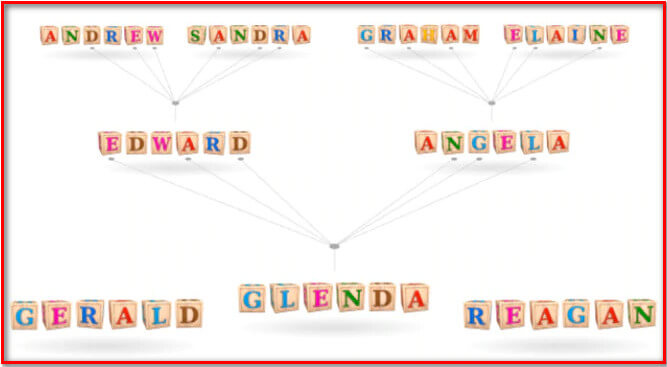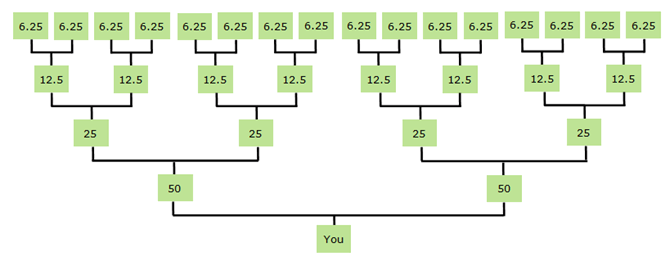DNA percentage ethnicity is measured by various important factors. Let’s discuss about all of its major points to deeply understand the DNA ethnicity and its percentage breakdown.
Unexpected Ethnicity Results
There are various things that causes shocking DNA ethnicity results. Most of those depend on how the DNA is passed down. Have a look at some of the reasons that affects DNA ethnicity results.
You don’t have inherited certain DNA because:
- DNA is inherited randomly.
- At most, someone’s only half DNA can be passed down.
- Other than your parents, the DNA amount you inherit from your ancestors is not fixed to 25% from each of the grandparent, 12.5% from each of great-grandparent and so forth.
This may have possibility that your DNA looks more like from your ancestor’s regions DNA than it does from the ancestor’s country.
Randomly passing DNA:
As you can see in the below image each letter denotes to a DNA segment. Reviewing the block, you will get an idea of how DNA passed is down from grandparents and makes her unique DNA. It needs to keep in notice that how the amount of DNA she received a particular ancestor decreases with the generation and how the DNA differs from their siblings. If you navigate back to the person’s family, there may be chance that she inherited no DNA from a certain ancestors.

Notice the patterns:
- Letters passed down randomly to the next generation.
- All the letters are not passed down.
- Same letters can be passed to multiple children.
- If an earlier ancestor has a letter, it is possible that their descendents may not.
- Siblings don’t have letter identical to each other (in a real person’s life, Siblings those are not identical twins approximately share 50% of their DNA with each other).
- More children having increases the chance of passing on more of one’s DNA, but even with three children, not both the siblings DNA segments made it to next level generation.
Ancestor’s DNA can’t be inherited more than 50%:
You will get 50% of the genes from each of your parent, but the DNA percentage you received from ancestor’s grandparent level and further back are not mandatory clearly divided in two with each of generation. Below available chart can displays a probability of percentage of genes you may inherit from ancestors going back to four generations.

At previous seven generations, less than 1% amount of your DNA is likely to come from any given ancestors.
Inheritance Prediction is not an exact Science:
You may inherit half of your DNA from each parent. The 50% DNA you receive are in random combination of their DNA, which in turn is based on the random combination of their ancestor’s DNA. Because the inheritance is random, one great-grandparent may passed on 12% of their DNA to you, while the great-grandparent may passed only 4% to you. Similarly, percentage of DNA ethnicity is not passed down in equal amounts. For instance if your fourth great-grandparent is 100% Korean and none of other ancestors are Korean, then DNA results might come back from the range in between 0-50% Korean, depending on the genes which you may have inherited from the part-Korean parent. (While statistically possible, 50% would be very, very unsatisfactory). Somewhere in between 0 and 2% would be typical.
Neighbouring region’s DNA often looks very similar:
Isolation may offer populations a opportunity to build a unique genetic signature. When people from multiple separated populations begin having children with each other, the prior distinct populations become harder to shown apart. A combination of this multiple lineages is called admixture. Admixed are mainly those regions that border each other.
For Instance, A Romanian DNA might displays in the Balkans or Eastern Europe & Russia regions or in the regions like Greece & Albania. DNA belonging to France & Germany and other European countries also looks pretty similar, because people who belong to those countries married to one another frequently as the time passes.
Ethnicity estimation is still a work in progress:
Estimating DNA ethnicity is still a challenge for us on which scientist across the globe are working. We offer the best possible estimate given based on the current data & knowledge, but also we are working hard to improve the precision of estimate ethnicity.
Siblings Share half of their DNA:
This is because only 50% of a parent’s genes are passed on to each of their children, your siblings may receive some genes that you didn’t and vice versa. If the ancestor or your parent’s genes were each a deck of 52 cards, then you would receive a number of 26 cards exactly from each of your parent to form the deck of 52 cards of your own. If you also had a younger sibling, then he or she may also receive 26 cards from each of their ancestors. And approximately half of their siblings 52 deck of cards would end up having the same card decks that you receive. If a third child/sibling were born, that sibling would share approx 26 cards from each of you as well. This DNA ethnicity pattern will continue with each of the sibling born. Due to the inheritance random nature, some siblings may inherit ethnicities more than others do, and some of the siblings may not able to inherit certain ethnicities at all.
Add Comment